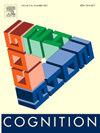人脸匹配的标准定位理论
IF 2.8
1区 心理学
Q1 PSYCHOLOGY, EXPERIMENTAL
引用次数: 0
摘要
人脸匹配是一项重要的应用任务,它需要对成对的人脸图像进行二进制决策,以确定这些图像是描绘同一个人(身份匹配)还是不同的人(不匹配)。虽然这些选择是相互排斥的,但匹配和不匹配试验的表现似乎是可分离的,这给理论发展带来了问题。目前的研究表明,这种分离源于系统反应偏差,反映了区分匹配和不匹配的决策阈值位置的个体差异。当这些偏差被控制或从分类精度中剔除时,匹配和不匹配识别之间的可靠关联就会被发现。这可以通过两个超过500名参与者的实验、几次面部匹配测试和一系列数据模拟来证明。这些发现支持了一种认知理论,即决策阈值位置的个体差异提供了识别面孔匹配和不匹配的机制。本文章由计算机程序翻译,如有差异,请以英文原文为准。
A criterion-placement theory of face matching
Face matching is an important applied task that requires binary decisions to pairs of face images to determine whether these depict the same person (an identity match) or different people (a mismatch). While these choices are mutually exclusive, performance for match and mismatch trials appears to be dissociable, which poses a problem for theory development. The current study demonstrates that this dissociation arises from systematic response biases, which reflect individual differences in the placement of decision-making thresholds to distinguish matches from mismatches. When these biases are controlled or partialled out from classification accuracy, reliable associations between match and mismatch identifications are found. This is demonstrated over two experiments with a sample of over 500 participants, several face-matching tests, and a series of data simulations. These findings support a cognitive theory in which individual differences in the placement of decision-making thresholds provide the mechanism by which the identification of face matches and mismatches are linked.
求助全文
通过发布文献求助,成功后即可免费获取论文全文。
去求助
来源期刊

Cognition
PSYCHOLOGY, EXPERIMENTAL-
CiteScore
6.40
自引率
5.90%
发文量
283
期刊介绍:
Cognition is an international journal that publishes theoretical and experimental papers on the study of the mind. It covers a wide variety of subjects concerning all the different aspects of cognition, ranging from biological and experimental studies to formal analysis. Contributions from the fields of psychology, neuroscience, linguistics, computer science, mathematics, ethology and philosophy are welcome in this journal provided that they have some bearing on the functioning of the mind. In addition, the journal serves as a forum for discussion of social and political aspects of cognitive science.
 求助内容:
求助内容: 应助结果提醒方式:
应助结果提醒方式:


